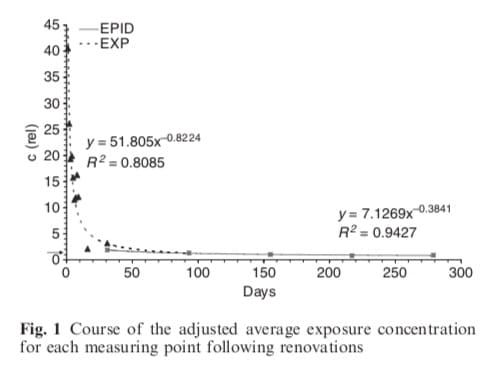Your home is your safe space. It’s where you find shelter and comfort, create memories with your family and de-stress after a long day — and it may also be making you sick. Here are five ways your home (or your workplace) could be harming your health and what you can do about it.
1. Moisture
High indoor humidity creates an ideal environment for mold to breed. And when mold breeds, your health suffers: According to the the Center for Disease Control (CDC), mold is associated with health issues that include throat irritation, coughing, wheezing and hypersensitivity pneumonitis. Mold aggravates asthma symptoms in people with the condition, and early exposure may lead children to develop asthma.
In addition to indoor humidity, water-damaged building materials and indoor leaks also create environments where mold thrives.
Here’s how you can reduce moisture to prevent mold at home:
- Fix leaks as soon as you notice them.
- Repair areas damaged by water.
- Run bathroom exhaust fans during and after bathing.
- Use a dehumidifier (and, perhaps, use the water to do your laundry).
Of course, if you already have mold in your home, you’ll need to take action to remove it — not just from your surfaces, but also from the air. AirPurifier notes that an air purifier is a cost-effective way to remove airborne mold, explaining, “In order to obtain the best results, you must purchase one of the best purifiers specializing in mold spore removal.” Most importantly, if you find mold in your home, call a professional to remove it — never attempt to do so yourself!
2. Dryness
Too much moisture is dangerous for your health, but so is too little. Dry indoor air dries out respiratory passages in the nose and throat. This not only leads to dry, itchy throats and nosebleeds, it also compromises your body’s ability to trap pathogens before they make you sick. Dry air also dries out your skin and causes skin conditions like eczema to flare up.
Thankfully, increasing indoor humidity is simple when you follow these tips:
- Turn down the heat, as artificial heat dries out indoor air.
- Decorate with houseplants to take advantage of transpiration.
- Install a humidifier.
3. Dust
Dusting your home does more than keep it looking great. When you remove dust, you’re also removing dust mites, eight-legged bugs too small to see with the naked eye. People with dust mite allergies experience congestion, sneezing, wheezing and other allergy symptoms in homes with high level of the mites. However, you should dust regardless of allergies because dust also harbors toxic chemicals like hormone-disrupting phthalates, phenols, flame retardants, and pesticides.
Want less dust at home? These steps will help:
- Vacuum regularly with a HEPA vacuum cleaner.
- Change HVAC air filters regularly to maximize their pollutant-trapping ability.
- Use a doormat to prevent dust from being tracked in.
- Maintain indoor humidity between 30 and 50 percent to inhibit the proliferation of dust mites.
4. Poor Airflow with accumulated unhealthy chemicals
A tightly sealed home may be great for your energy bills, but it’s not so good for your health. In fact, there are over 85,000 human-made chemicals, many with health consequences. Building materials, carpets (GUT standard purportedly has low VOC carpets), paint (no and low VOC options exist), appliances, and cleaning supplies release toxic chemicals known as volatile organic compounds, or VOCs (see CDC). These compounds have been found in unsafe levels in homes (see below), schools, and malls. If your home isn’t circulating fresh air inside (and probably also filtering), VOCs accumulate and contribute to health problems.
In the short term, you might notice headaches, nausea, dizziness and nose and throat irritation. There is some evidence that VOCs can affect the IQ of developing fetuses as well. Additionally, the EPA reports that long-term exposure to VOCs damages the liver, kidneys, and central nervous system, and may cause cancer.
High concentrations of VOCs are especially true after renovation. A 2010 study (“Decreasing concentrations of volatile organic compounds (VOC) emitted following home renovations” in Indoor Air) compared VOCs after renovation in 11 homes and offices with VOCs present in 243 homes without renovations. Results are shown in figure 1 (below), with an exponential decrease in VOC concentrations in the first 30 days and achieving normal indoor pollution levels (.3 mg/m3) by day 77. Their results are consistent with other studies. For example, Brown (2002, as cited in the 2010 study), found VOC decay was best fit with two exponential models, one capturing fast initial decay up to 20 days, folllowed by a another curve capturing a long-term decay lasting 246 days. Ultimately, the authors recommend a minumum of 60 days before occupancy after renovation with 14 days being possible with increased ventilation.
Increase airflow and reduce VOCs in your home by:
- Opening the windows to promote air exchange. However, this 2016 study found that ventilation did not have an appreciable effect on long-term health problems and recommended filtering for inclusion in further research.
- Using an air purifier capable of trapping harmful gases. While HEPA filters are good for particulate matter (see whole house filters generally or this filter that combines HEPA and Activated Carbon for the whole house or this filter that can fit most existing furnaces), activated carbon filters are what you need for VOCs (although see this article for an up-and-coming technology that might be better eventually). You can buy dedicated filters or make your own by attaching activated carbon filters (like these) to an ordinary fan. For data about the effectiveness of this and a DIY project gone commercial, see this site.
-
Photo-Ionization Detection (PID) is the standard for detecting VOCs but cost about $3,000 for a suitable unit (e.g., AQ VOC; see this article for discussion of measuring VOCs). So, a more affordable approach would be hiring a professional tester listed with the Indoor Air Quality Association.
- Using non-toxic cleaning supplies.
- Choosing formaldehyde-free building materials and low-VOC or no-VOC paints when remodeling, such as products recommended by the Greenguard Environmental Institute.
- Opting for bedding, carpeting, and clothing made from natural fibers rather than synthetics.
- Decorating with houseplants known to remove pollutants from indoor
- Install an air-exchanger that circulates indoor and outdoor air while maintaining heat or cooling efficiencies
Polybrominated Diphenyl Ethers (PBDEs) are used as a flame-retardant, are found in consumer goods such as electrical equipment, construction materials, coatings, beds, textiles and polyurethane foam used as furniture padding (source). The Environmental Working Group reports that “A growing body of research in laboratory animals has linked PBDE exposure to an array of adverse health effects including thyroid hormone disruption, permanent learning and memory impairment, behavioral changes, hearing deficits, delayed puberty onset, decreased sperm count, fetal malformations and, possibly, cancer.” Since we spend a third of our lives in bed, one simple way to reduce your exposure is to make sure you get a bed without these harmful chemicals.
5. Blue light
There is now evidence that blue light from electronic screens causes permanent and cumulative retina damage, with a recent study articulating the mechanism for this damage (article). Consider using night or warm settings on your screens, also a good idea to promote good sleep.
You don’t think of your home as a dangerous place. However, if you’re not paying attention to indoor air quality, you could be putting your family’s health at risk. Because the average person spends much of their time indoors at home, small levels of pollutants add up to a serious health threat. While you can’t eliminate every pollutant from your home, taking these steps will create a safer, healthier home for your family. For a more in-depth look at healthy homes, see this site.


